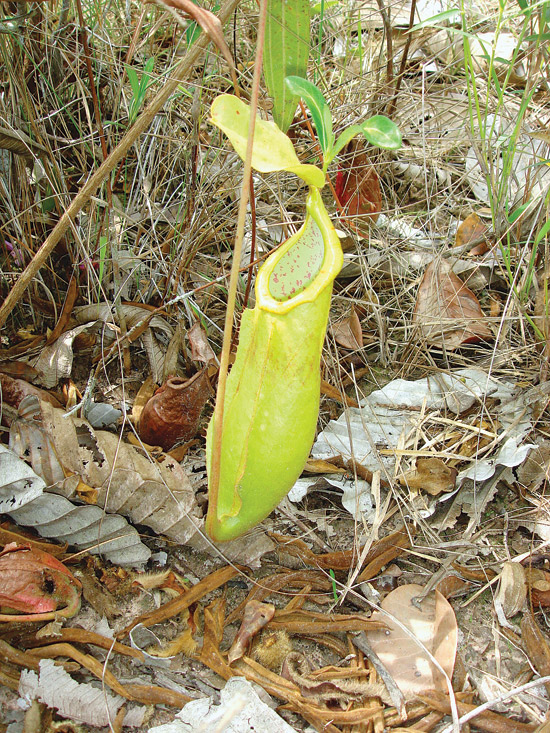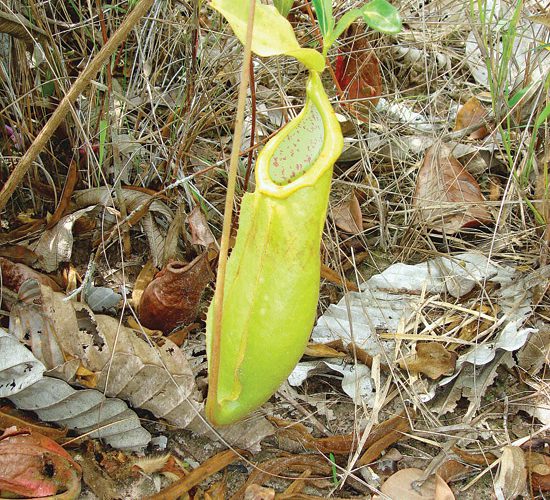(No.9, Vol.2, Sep 2012 Vietnam Heritage Magazine)

Nepenthes thorelii

Drosera burmannii

Drosera indica
Alongside plants that absorb sunlight energy, there exist those that feed on flesh. Carnivorous plants are distributed throughout the world, especially in arid places with harsh climates and soil conditions. In Vietnam, although carnivorous plant species have not yet been adequately counted, two well-known families are the Sundew family Droseraceae (three species) and the Pitcher Plant family Nepenthaceae (two species).
In mid 2012, Vietnamese researchers from the Institute of Tropical Biology, as well as some French scientists, announced their discovery of the carnivorous Nepenthes thorelli– the Thorel Pitcher Plant– in Lo Go – Xa Mat National Park in Tay Ninh Province. This was the first time scientists observed this species of plant in over a century.
As the morning sun awakes, somewhere amongst the swamps and arid coasts, the Droseraceae also wakes to begin a day of catching its life-sustaining prey. First, it opens its brilliantly-coloured flowers, which are redolent with a seductive scent that it releases to the winds. The fragrant flowery scent causes hungry insects to awaken from their sound sleep and seek out a morning meal to savour. At the same time, the ends of the long slender hairs that surround the plants’ stalks and the flowers exude sticky juices that are dulcet, fragrant and highly adhesive, in order to deceive and snare esurient prey– from the amorous butterfly to the industrious bee, to even the most keen and agile fly.
In order to prevent their sticky coating from drying out in the heat of the sun and rendering their traps ineffective, the Indian Sundew Drosera indica and the Shield Sundew Drocera peltata open their flowers and release their sticky juices before dawn. However, the juices of the Burmese Sundew Drosera burmannii have evolved even further. In spite of the light of the sun glaring down on them, they still do not become entirely dry and brittle, and they retain their ability to stick to their prey, albeit not as well as at daybreak. Almost all the juices excreted from species of Droseraare capable of capturing insects and vigorously digesting them. On top of that, their leaves are able of absorbing nutrient from their prey. For this reason, the plants are able to digest and absorb any insects that get stuck in their traps. These nutrilites constitute a source of supplements essential to the plant’s growth and sustenance, since the plants are incapable of collecting some minerals from the earth as do other plants in nature.
In contrast to the strategy of using sticky juices to conclude the lives of prey, species of the Pitcher Plant Nepenthaceae use an even more elaborate method. Their leaves have long pedicles, the corners of which transform into broad false leaves. The middle portions spiral long and narrow, while the top portions of the leaves form cylinders with the leaves themselves shaped like a pitcher’s lid. These cylindrical ‘pitchers’ are narrow at the bottom, where fragrant secretions are released to entice prey– almost entirely insects. The mouths of these ‘pitchers’ also excrete honey-like secretions. The walls of the ‘pitchers’ are smooth. Their lower portions and pits are full of glands that release digestive juices. Insects are enticed due to alluring substances leading them to food, but the insects are unaware that it will be their final meal. When they are drawn to the honey-like juices, the insects may fall straight inside the pitchers. The pitchers’ lids immediately clamp down. Even flying insects have no way to escape, since the narrow walls of the pitchers make it difficult to fly back out vertically. The insects that fall to the bottoms of the pitchers, which are filled with digestive enzymatic juices and bacteria, can only await death and digestion to provide nutrilites for the alluring plants.
When the scientist Lecomte named the Thorel Pitcher Plant, scientists across the globe were only aware of about 40 species of Pitcher Plant and the Thorel Pitcher Plant first discovered by French botanist Clovis Thorel in Thi Tinh hamlet, Lo Thieu district, Binh Duong Province around 1861-1869. At that time, the Pitcher Plant specimens were called Thorel 1032. In 1909, botanist Paul Henri Lecomte formally described the species and took ‘Thorel’ to name it Nepenthes thorelli in order to commend the contributions of its discoverer. From the time that Bios collected such specimens in Binh Duong in 1903 to the time the team lead by Dr Luu Hong Truong (PhD) of the Institute of Tropical Biology found it in Lo Go – Xa Mat National Park in 2011, no one had recorded the existence of the Thorel Pitcher Plant in its natural habitat.

Drocera peltata

,,
,,

